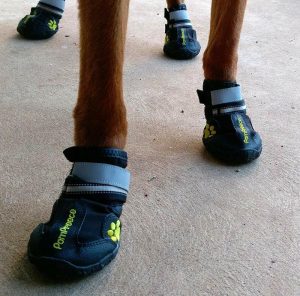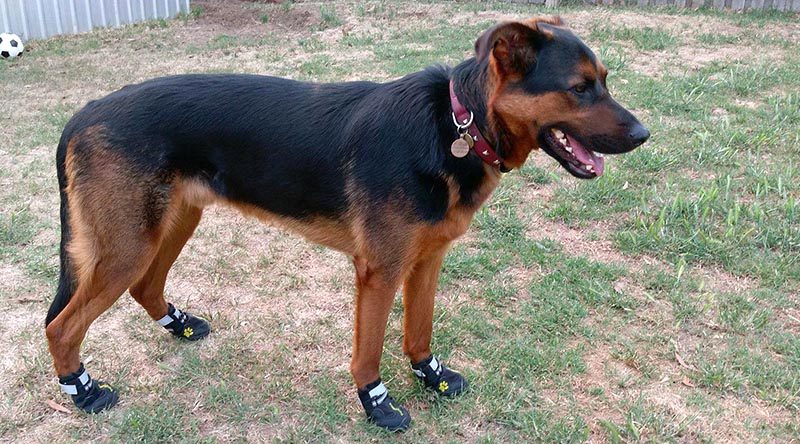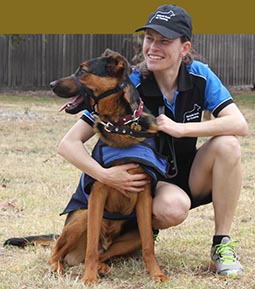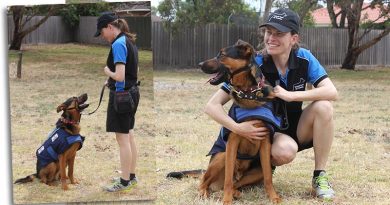Heat and dogs

As we approach warmer weather we need to ensure our pets are kept cool and comfortable.
Dogs release heat not by sweating but by panting and releasing heat through the pads on the bottom of their paws.
Dogs are not able to cope with heat in the same way people can. Even if doesn’t feel that hot to you, it may be too hot for your dog.
Some tips to make summer bearable
As the trainer of a Service Animal I can’t take the risk of injury to my dog.
Starting with basic common sense – don’t leave your dog in the car! It takes only a few minutes for temperatures to soar.
Daily walks. If it’s too hot for you to walk barefoot on the footpath/road don’t make your dog walk on it.
Dog paws can easily become burnt and blistered from even the shortest walks on hot surfaces. If you don’t believe me, Google it – the images are disturbing.
A dog’s excitement can override pain on a walk, meaning the dog may not be showing pain or discomfort, and you may not be able tell until it’s too late.
Walk your dog early morning or late evening.
If you are unsure if the ground is cool enough to walk on place the back of your hand on the pavement to check.
Bring your dog into the air-conditioned house when possible.
Ensure there is always fresh water available in multiple bowls. Sometimes dogs accidentally knock over their bowl so be prepared.
Make sure your dog’s kennel is out of direct sunlight and that your dog has enough shaded areas to shelter from direct sunlight.
Fill up a plastic kiddy pool/clam shell so your dog can cool off if he needs. The pool can also provide an additional water source to keep him hydrated (and it’s harder to knock over than a bowl).
There are cooling mats available online that can be beneficial, though these are not suitable for dogs who are avid chewers.
Cool treats can help ease a hot day. Freeze dog biscuits or pieces of meat in a container of water and place it out in the shade as an icy treat. Frozen (uncooked) chicken wings and necks can make a refreshing treat.
If you want to hose your dog, focus the water under the dog where the water can easily cool the blood vessels.
Signs of heat stress in your dog
- Heavy rapid panting
- Excessive drooling
- Reddened gums
- Rapid heartrate
- Vomiting
- Seizures
- Trouble walking
- Lethargy
Heat stress can cause organ failure and death.
If you believe your dog is heat stressed you must act immediately, every second counts!
Cool the dog down by running cool (not freezing) water over the dog, focusing on the dog’s belly. Offer him water to drink and immediately transport your dog to the nearest vet clinic for treatment.
Your dog may require intravenous fluids to help him rehydrate and medical monitoring of his recovery.
Please don’t use a wait-and-see approach when it comes to heat stress, dogs can become very ill, very quickly and go into shock.
If you want to be super prepared there are special pet first aid courses available.
If in doubt always take your dog to the vet.
Dogs boots

For Service Dog work it is important for dogs to be able to work under a variety of conditions, including walking on hot bitumen between appointments in the city.
For hot days you can have your dog wear dog boots (see Paddington, in the photo, ready for rough ground or hot pavement).
If you buy quality boots they will have a sole, like a human shoe, able to withstand walking on hot surfaces.
Dog boots are also handy for taking your dog over rough, rocky terrain or where there are lots of burrs or grass seeds.
How do I know what size my dog is? Each brand is different but there will be a sizing chart to measure your dog’s paws.
How do I get my dog to wear them? It comes down to basic training principles.
Step 1: Can you handle your dog’s paws when you check for grass seeds? If the answer if no, you need to start basic handling drills. Don’t start by grabbing the dog’s paw and holding it – instead, touch your dog’s paw, give him a treat. You want this to be a non-stressful, non-threatening activity. It may take several sessions to build up to being able to gently hold his paw.
Step 2: After your dog has become comfortable with handling his paws you can progress to trying on the boots. Once again this needs to be a non-stressful activity. Slip one boot on him and treat him frequently so he is more interested in you than the boot. All dogs walk funny when they first wear boots, they will get used to them.
Step 3: Repeat the drills frequently until the dog can wear all four boots.
You can also use the above paw-handling exercise to prepare your dog for vet checks. It can prove handy in reducing your dog’s stress levels if for any reason he has to have his paws examined or nails trimmed.
As with any dog training, have fun with it and enjoy the warm weather with your best friend!
.
,
Melanie Scott is a former police officer with PTSD. She is a qualified dog trainer who is passionate about dogs and helping first responders. Melanie Scott K9 Training (MSK9T) offers a variety of services including group dog-obedience classes, puppy classes, private in-home consults, as well as therapy and service-dog training. You can contact Melanie on 0448 395 797 or visit her web site.
.
.
.
.
.
.
.
.

.
.






